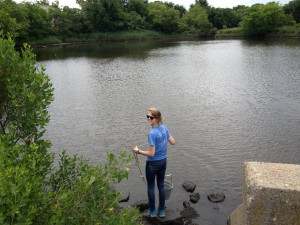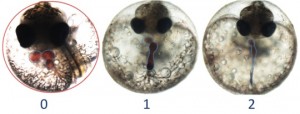By Sasha Burwell

Or, heart deformers, at least. Being an intern within Project 3 of the Duke Superfund Research Center this summer has been an amazing experience. Project 3 examines the effects of early life exposure to polycyclic aromatic hydrocarbons (PAHs) and later life consequences to the development and function of Fundulus heteroclitus, or killifish, taken from the Atlantic Wood Superfund Site in Virginia, and from other sites along a spectrum of contamination levels, including a reference site. For the past month, I have been helping my mentors, Dr. Nishad Jayasundara and Jordan Kozal, find the optimal drug concentrations for use with the Seahorse Bioscience XFe Analyzer. They are attempting to accurately measure the metabolism of whole zebrafish and Fundulus hearts, and potentially that of their brains as well.
When most people think of metabolism, what comes to mind is their body’s ability to digest food. However, metabolism in terms of a cell or a tissue, such as the heart or the brain, has a somewhat different meaning. It refers to the set of processes by which organic compounds (from the food you have been eating) are broken down to create ATP, or energy that the cell can use. The efficiency of a cell to create energy impacts its ability to function properly. For example, if a heart is incapable of metabolizing all the energy it needs, it may not circulate blood properly, and the organism will suffer as a result. The XFe Analyzer measures the oxygen consumption rate of the tissue, which acts as an index for the level of mitochondrial respiration and thus the metabolic efficiency of the tissue.

In addition, I have been working with Nishad on a project focused on the combined effects of temperature and PAH exposure on Fundulus heteroclitus embryos. It is well documented that killifish from the Atlantic Wood site are resistant to the PAHs in their environment, and that in their non-resistant relatives, early life PAH exposure can cause serious cardiac deformities such as a tube heart (see figure 1). Previous studies have shown that temperature affects the rate of embryonic development, so we are curious about how changes in temperature affect PAH toxicity. With help, I spawned Fundulus embryos from Atlantic Wood, King’s Creek –our reference site –, and Jones Creek. Twenty-four hours after fertilization, I exposed almost 400 of these embryos to varying levels of Elizabeth River Sediment Extract, and then allowed these embryos to develop in incubators along a range of temperatures. Nishad and I later examined the embryos for cardiac deformities; since Fundulus embryos have a transparent embryo membrane, their heart is easily visible under a microscope.
28°C is the optimal temperature for killifish development, and the King’s Creek embryos showed increased rates of cardiac deformities at temperatures other than this optimal one. Atlantic Wood and Jones Creek embryos also showed clear variance in the average severity of heart problems among the different temperatures. I examined the embryos again for mortality after two weeks had passed. So far, we’re seeing that the fluctuating temperature groups have a surprisingly high survival rate, which is interesting because in a real-world setting temperature will vary.
My main goals for this summer were simply to experience a lab environment and learn first-hand what it is like to conduct research, while gaining basic lab skills that are widely applicable. These goals have been fully met: I have worked in the lab, and have even been to the field to collect fish from Atlantic Wood and other sites; I have observed and followed and participated in research. Before this internship, I had been considering a future in scientific research, but I was unsure if I would even like performing research, or if it would be the best path for me to take. Now, thanks to my time in the Di Giulio laboratory, I know that research is at times frustrating, but is always fascinating, and that I would definitely enjoy a career which allows me to work in a laboratory.




